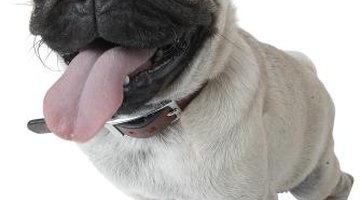White dog fur turns red due to staining. It is typically found below the eyes, around the chin, on the feet and around the penis or vulva. The staining can occur on any colour fur, but is most noticeable on white dogs. The main cause of this reddish discolouring is thought to be prophyrin, a protein found in body fluids such as tears and saliva.
Eye Issues

Red staining below the eyes is usually due to excessive tearing. A dog's eyes may tear because of an anatomical problem, such as shallow eye sockets, extra skin folds around the eyes or blocked tear drainage ducts.
Excessive tearing can be compounded by eye irritation from rolled-in eyelids that rub the surface of the eyeball, abnormal hair growth on the inside edge of the eyelid and eye infections. It is further exacerbated when hair around the eye touches it and wicks tears from the eye's inner corner down the face.
- Red staining below the eyes is usually due to excessive tearing.
- Excessive tearing can be compounded by eye irritation from rolled-in eyelids that rub the surface of the eyeball, abnormal hair growth on the inside edge of the eyelid and eye infections.
Allergies
Allergies that irritate the eyes can cause excessive tearing, leaving stains on the face. Skin allergies are also an underlying cause of fur staining in other areas, particularly the feet, lower legs, inner thighs and genitals. When the skin becomes irritated and itchy, the dog will lick and chew these areas excessively, causing saliva staining. The skin below the stained fur will usually be red and inflamed if there is a skin allergy.
- Allergies that irritate the eyes can cause excessive tearing, leaving stains on the face.
Red Yeast and Bacterial Infections
Some researchers believe skin infections can further intensify red staining. When a dog's skin is constantly wet with tears or saliva, it becomes a breeding ground for red yeast and bacteria. Mild skin infections may or may not be inflamed, but they are frequently discoloured and have a noticeable odour. Severe skin infections may ooze or ulcerate.
- Some researchers believe skin infections can further intensify red staining.
- Mild skin infections may or may not be inflamed, but they are frequently discoloured and have a noticeable odour.
Food Additives and Minerals
Some dog breeders believe that dog food additives and water minerals can also contribute to red fur stains. They report a reduction in staining after changing the dog's diet, especially to a raw meat diet, and when serving purified water with a low mineral content.
Treating Underlying Causes of Fur Stains
If your dog has fur stains due to excessive tearing or skin allergies, schedule a visit with your veterinarian. Some eye issues can be serious, resulting in blindness, if left untreated. Skin allergies are prone to becoming infected and also require medical attention.
